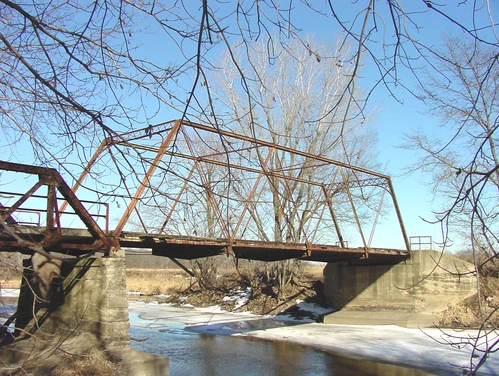- Year constructed: 1876; moved 1916
- Bridge type: Pin-Connected Warren Through Truss Span
- National Register of Historic Places status: Listed
- Length: 163 feet
- Width: 15.8 feet
- Spans: 1
- FHWA: 314920
- Jurisdiction: Story County
- Location: Ken Maril Road over the Skunk River, 4 miles southeast of Ames, Section 24, T83N-R24W (Washington Township)
Details
In April 1876 the Story County Board of Supervisors directed County Clerk S.J. Shearer to advertise for three iron bridges over the Skunk River. One would span the river at Soper's Mill north of Ames, the second would be located in Grant Township, and the third would span the Skunk River just eat of the small town of Cambridge, in Union Township. By far the longest of the three, this last bridge consisted of an 80-foot wrought iron truss supported by cylinder piers over the river's channel, with a 200-foot timber pile approach. The contract to fabricate and erect the three spans was awarded in June to the King Iron Bridge and Manufacturing Company of Cleveland, Ohio.
King apparently completed the three bridges later that year, but in September 1877 the Cambridge Bridge already required repairs. The truss's deck and stone substructure needed occasional repairs in subsequent years, the most serious of which was a partial reconstruction of the crumbling stone abutments in 1899. By the mid-1910s the Cambridge Bridge was no longer sufficient to carry traffic at this crossing. In 1916 the county hired the Cole Brothers Construction Company of Ames to replace the bridge and to move the old truss to a new crossing of the Skunk River southeast of Ames. Here it was combined with an ISHC-standard pony truss on a new concrete substructure. Coincidentally, this reconstruction cost of $6,600 - the same amount as the original bridge had cost to build in 1876. The bridge carried extremely light traffic at this remote location until about 1990, when the road was vacated and the bridge abandoned in place.
The Skunk River Bridge employs a classic Warren truss configuration, with a web that relies on simple triangulation for its rigidity. "The term Warren truss girder was originally applied only to the particular case of the Triangle truss in which the web triangles are all equilateral; but later writers generally use the name for any triangular truss, noted bridge engineer J.A.L. Waddell wrote in his 1916 treatise Bridge Engineering. "As there is no special advantage in making the web triangles equilateral, there does not appear to be any good raison d'etre for the use of the true Warren type." In a state dominated by bowstrings and Pratt trusses in the 1870s and early 1880s, relatively few Warren trusses were built. Only a handful survives to the present, of which the Skunk River Bridge is the oldest. Built during the county's formative years by the nation's most prolific bridge fabricator, it is an important early transportation related resource.
Adapted from Fraser 1992
Areas Served
- Story
